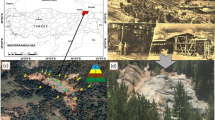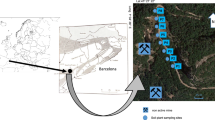Abstract
This study assessed the residual contaminant load of three groups of artisanal gold mining (ASM) impacted lands, thereafter, phytoremediation techniques using Jatropha curcas, Manihot esculenta and organic amendments were used for mitigation. A total of 110 soil samples from 30 ASM sites were investigated for their total contents of Cd, As, Pb, Hg, Zn, Fe and Al. After sample digestion, ICP-MS was used for content determinations. Using activated neem seed extracts (NE) and poultry manure (PM) at different application rates, the phytoremediation potentials of Jatropha curcas and Manihot esculenta were assessed for 270 days after planting. The obtained data were analyzed with SPSS statistics 28 for the ANOVA. The results indicated mining spoils were suppliers of toxic elements in the soil however, their distributions per contaminant varied based on the properties of the ore materials mined. As a result, mine spoils created the processing of oxide and underground rock ores supplied contents of As, Fe, Al, Cd and Zn much more than alluvial mining sites and above tolerable threshold levels. Both J. curcas and M. esculenta exhibited phytostabilizing potentials as larger portions of absorbed elements were stored in their root organs. However, the application of a 25% mixture of neem seed extract and poultry manure or 25% poultry manure only (w/w) to soils reduced the uptake capacity of potentially toxic elements by J. curcas and M. esculenta by 19-38% and 10.4-45% respectively.
Access provided by Autonomous University of Puebla. Download conference paper PDF
Similar content being viewed by others
Keywords
1 Introduction
Due to their presence in the food chain and related health implications, potentially toxic elements “PTEs,” in the ecosystem have drawn more attention globally [1, 2]. Even though their presence in the environment may be natural, PTEs loads in the ecosystem have been dramatically worsened by anthropogenic channels such as pharmaceutical products, untreated wastewater discharges, agrochemicals, mining, and ore processing [1, 3, 4]. With their binding connection with ore bodies, mine wastes have been regarded as hotspots for PTEs like Al, As, Pb, Ti, Cd, Fe, Mn, Ni, and V in the environment [5, 6]. This means the quality, safety, and integrity of environmental media including plants, air, soil, and surface and groundwater resources, near mining areas are thereby compromised because of their persistence [7, 8].
Because of historical mining and/or industrial use reasons, many areas in Southern and Central Saxony, North Rhine-Westphalia, Germany have predominantly high levels of PTEs in their soils, making some of them unsafe for use as playgrounds for kids [2, 9, 10]. Near a silver mine in Iran, different Cr, Cd, and Hg concentrations that were higher than their permissible threshold levels were discovered [4]. While the tremendous industrialization effort in China alone was responsible for approximately 2 million hectares of polluted soils at a rate of 46,600 ha/year [11]. The result is the significant contamination of terrestrial and aquatic environments, as well as of their products, which has a negative impact on health and the ability of the world to achieve environmental sustainability [4]. Because most PTEs are often not biodegradable, human exposure to levels beyond the acceptable threshold results in increased health risks as they easily get absorbed into their tissues [12].
There are many ways to clean up PTEs-filled media which may include biological, chemical, or physical [13]. However, the implementation of any choice has additional effects on price, soil quality and structure, and the viability of implementation in vast regions. Interestingly, compared to conventional treatment approaches, phytoremediation has shown to be a more economical and environmentally favourable [14,15,16,17]. There are numerous phytoremediation methods, including rhizodegradation, phytoextraction, phytostabilization, phytofiltration, phytodegradation, and phytovolatilization [13, 18]. However, their relevance depends on the intended outcome of the program for soil remediation because different plants have unique qualities for adaptability and effectiveness. However, for increased success rates the use of native hyperaccumulators that are well adapted must be ensured [15, 19]. In the Ghanaian setting, different types of ore bodies are mined and processed artisanally. However, all previous studies have treated such mine spoils as similar entities devoid of the characteristics of the parent materials mined. Additionally, investigating phytoremediation which is reasonably inexpensive and simple to implement presents a more sustainable option. However, inadequate information on the management options for potential accumulator plants exists. In most instances, native plants that had naturally colonised a site were examined for their PTE contents. In this case, background physicochemical and growth conditions were unknown or forecasted in some instances. Therefore, this investigation was carried out to ascertain the potential differences in total contents of Cd, As, Pb, Hg, Zn, Fe and Al contaminant load in different artisanal mining sites and phytoremediate them using native plants and organic amendments.
2 Materials and methods
2.1 Geology of Study Location and Sampling
This study was undertaken between January 2020 and July 2022 in Southern Ghana. The geology of the area falls within the Paleoproterozoic Tarkwaian and Birimian group formations and receives an average rainfall of about 1900 mm per annum [20]. The area is a hot spot for artisanal mining due to the presence and richness of free metallic gold dust [21]. Triplicate soil samples from 30 artisanal mining sites were further categorised into three distinct groups due to their differences in the type of ore materials mined and their resultant mine spoil characteristics. Whilst 20 independent soil samples from nearby (>1 km) forest areas were taken for control purposes. Thus, a total of 110 soil samples were analysed in this study. The digestion and analysis of processed samples were done according to the methods used by Okoroafor et al. [17].
2.2 Experimental Design
In a pot experiment conducted outside of a greenhouse, bulk soil from a mining site with well-determined physicochemical parameters (Average total contents of 28.52, 326.17, 30.08, 7.60, and 261.39 mg/kg of Cd, As, Pb, Hg, and Zn, respectively) was used. For the removal of PTEs from the soil by plants, nursed Jatropha curcas seedlings and pre-sprouted Manihot esculenta stem cuttings were used. Different kinds and amounts of organic amendments were added to the mine soil before curation and independent planting. These included thoroughly mixing both activated neem seed (NE) and poultry litter (PM) at application rates of 15% and 25% (w/w), or independently at the same rates. Destructive harvesting was carried out 270 days after planting (DAP) where soil samples and plant parts (shoot and root) were washed thoroughly and air-dried and milled for further analysis using the methods mentioned above. Using IBM SPSS version 28, a one-way analysis of variance (Welch test) between means was made between mine spoil types and bioaccumulation abilities of plants under the different treatments at a 95% significance level.
3 Results
3.1 Contaminants in Mine Spoil Types
The chemical distribution of target contaminants in the different mine spoils is presented in Table 1. Apart from soil As the total average contents of all PTEs in the forests were within tolerable limits whilst the Urs and OxS mine spoils were more contaminated than the Avs mine spoils.
3.2 Biostimulation Effects of Organic Amendments on Plant’s Phytoremediation Abilities
Although both plants absorbed target PTEs mostly through their roots, distinct treatments had varying effects that were statistically different (p< 0.05) from one another. For instance, the application of 25% NE+PM resulted in the largest decrease in PTE uptake by both test plants. Aside from Cd uptake (in both shoot and roots) and Pb uptake (in the roots alone) in J. curcas (Figure 1), M. esculenta surpassed J. curcas in the uptake of Pb and Zn by 10.3 and 6.6%, respectively, whilst J. curcas exceeded it in the removal of soil As, Cd, and Hg by 13.4, 0.02 and 6%, respectively.
Under all treatment conditions, J. curcas and M. esculenta showed output ranges (min-max) of 37.0–77.1% and 30.3–63.7% for As, 37.8–75.5% and 32.9–74.4% for Cd, 37.8–75.5% and 32.9–74.4% for Pb, 44.0-72.2% and 44.1-66.2%, for Hg and then 34.5–77.0% and 36.1–83.6% for soil Zn more than their respective controls. However, the application of 25% NE+PM followed by 25% PM caused the largest immobilization of PTEs in soils than the remaining amendment additions/ rates. Both plants' limited shoot accumulations often followed the same trend as their corresponding root accumulation as no shoot was able to absorb up to 30% of the target PTE under the various treatments. The applied organic amendments further resulted in up to 1.25 higher in dry biomass weights.
4 Discussions
4.1 Contaminants in Mine Spoil Types
The differences (p < 0.05) in PTE load between different types of mine soils and forest soils demonstrated the potential influence that human-induced weathering through mining and the variations in the geochemical characteristics of the ore materials mined. Thus, rocks and oxide gold ores were larger suppliers of PTEs in the mine environment than the alluvial ore forms. According to Bundschuh et al. [22], the cumulative levels of both Fe and Al, and then As in at UrS and OxS sites investigated surpassed the 20,000 and 5 mg/kg maximum background contents for natural soils, respectively as these elements have binding connections to gold. We found that the dangers of UrS and OxS mine spoils were largely due to extreme contents of As, Hg and Cd and pose serious ecological safety and human health concerns as the order of site contaminations was OxS> UrS> AvS> FS amongst sites.
4.2 Immobilization Effects of Organic Amendments on Plant’s Phytoremediation Abilities
Whereas the test plants were able to absorb appreciable contents of soil PTEs, the decreases even though varying in plants' PTE uptake in response to applied organic amendment demonstrates their different influence on soil geochemistry and plant physiology. Thus, adding 25% NE + PM to soils may have given soils the combined advantages of biochar addition, which includes the sorption of PTE to itself and made them not readily available for uptake by plants. Whilst the delivery of nutrients and carbon to soils for plant growth through the addition of PM increased biomass production [23,24,25]. Therefore, compared to other treatments, this combination may have improved soil governing conditions such as soil nutrient enrichment and improved soil microbial functions. Owing to the limited capacities for shoot uptake which caused a lower transfer coefficient < 1, J. curcas and M. esculenta may be best used as phytostabilizers [26]. The application of 25% NE + PM followed by 25% PM can further immobilize soil PTE that might have been absorbed by plants.
4.3 Conclusion
To efficiently reclaim degraded mining soils, knowledge about their contaminants load is required. This study, therefore, analysed 110 soil samples from 30 artisanal mine sites which had visible disparities in their spoil characteristics due to differences in ore materials mined and processed. Laboratory analysis showed that, sites, where hard rocks and oxide gold ores were mined and processed, contained contents of PTEs far above their respective tolerable threshold limits as compared to alluvial mine spoils or forest soils. The toxicity to ecosystem fell in the order OxS > UrS > AvS > forest soils.
The use of J. curcas and M. esculenta proved to be efficient in phytostabilising multi-contaminated soils due to their high root bioaccumulation potentials than in above-ground parts. However, the addition of 25% activated neem seed extract and poultry manure was able to decrease the uptake of more toxic elements in the soil by plants than in their natural state. Using effective root cleansing plants can offer opportunities to reduce possible toxicity to primary consumers in the food web.
References
Li, L., Wu, J., Lu, J., Min, X., Xu, J., Yang, L.: Distribution, pollution, bioaccumulation, and ecological risks of trace elements in soils of the northeastern Qinghai-Tibet Plateau. Ecotoxicol. Environ. Saf. 166(July), 345–353 (2018). https://doi.org/10.1016/j.ecoenv.2018.09.110
Tóth, G., Hermann, T., Szatmári, G., Pásztor, L.: Maps of heavy metals in the soils of the European Union and proposed priority areas for detailed assessment. Sci. Total Environ. 565, 1054–1062 (2016). https://doi.org/10.1016/j.scitotenv.2016.05.115
Deveci, T.: Assessment of trace element concentrations in soil and plants from cropland irrigated with wastewater. Ecotoxicol. Environ. Saf. 98 (2013). https://doi.org/10.1016/j.ecoenv.2013.08.013
Soltani, N., Keshavarzi, B., Moore, F., Sorooshian, A., Ahmadi, M.R.: Distribution of potentially toxic elements (PTEs) in tailings, soils, and plants around Gol-E-Gohar iron mine, a case study in Iran. Environ. Sci. Pollut. Res. 24(23), 18798–18816 (2017). https://doi.org/10.1007/s11356-017-9342-5
Ramírez, O., Sánchez de la Campa, A.M., Sánchez-Rodas, D., de la Rosa, J.D.: Hazardous trace elements in thoracic fraction of airborne particulate matter: assessment of temporal variations, sources, and health risks in a megacity. Sci. Total Environ. 710, 136344 (2020). https://doi.org/10.1016/J.SCITOTENV.2019.136344
Mensah, A.K., Marschner, B., Shaheen, S.M., Wang, J., Wang, S.L., Rinklebe, J.: Arsenic contamination in abandoned and active gold mine spoils in Ghana: geochemical fractionation, speciation, and assessment of the potential human health risk. Environ. Pollut. 261 (2020). https://doi.org/10.1016/j.envpol.2020.114116
Affum, A.O., et al.: Influence of small-scale gold mining and toxic element concentrations in Bonsa river, Ghana: a potential risk to water quality and public health. Environ. Earth Sci. 75(2), 1–17 (2016). https://doi.org/10.1007/s12665-015-5000-8
Hilson, G.: The environmental impact of small-scale gold mining in Ghana: Identifying problems and possible solutions. Geogr. J. 168(1), 57–72 (2002). https://doi.org/10.1111/1475-4959.00038
Rinklebe, J., Antoniadis, V., Shaheen, S.M., Rosche, O., Altermann, M.: Health risk assessment of potentially toxic elements in soils along the Central Elbe River, Germany. Environ. Int. 126, 76–88 (2019). https://doi.org/10.1016/j.envint.2019.02.011
Wiche, O., Zertani, V., Hentschel, W., Achtziger, R., Midula, P.: Germanium and rare earth elements in topsoil and soil-grown plants on different land use types in the mining area of Freiberg (Germany). J. Geochem. Explor. 175, 120–129 (2017). https://doi.org/10.1016/j.gexplo.2017.01.008
Xiao, R., Wang, S., Li, R., Wang, J.J., Zhang, Z.: Soil heavy metal contamination and health risks associated with artisanal gold mining in Tongguan, Shaanxi, China. Ecotoxicol. Environ. Saf. 141, 17–24 (2017). https://doi.org/10.1016/j.ecoenv.2017.03.002
Zhang, Z., Wang, Q., Zheng, D., Zheng, N., Lu, X.: Mercury distribution and bioaccumulation up the soil-plant-grasshopper-spider food chain in Huludao City, China. J. Environ. Sci. (China) 22(8), 1179–1183 (2010). https://doi.org/10.1016/s1001-0742(09)60235-7
Mehes Smith, M., Nkongolo, K., Cholewa, E.: Coping mechanisms of plants to metal contaminated soil. Environ. Chang. Sustain. 53–90 (2013). https://doi.org/10.5772/55124
Mahar, A., et al.: Challenges and opportunities in the phytoremediation of heavy metals contaminated soils: a review. Ecotoxicol. Environ. Saf. 126(April), 111–121 (2016). https://doi.org/10.1016/j.ecoenv.2015.12.023
Kobina, A., Marschner, B., Antoniadis, V., Stemn, E., Shaheen, S.M., Rinklebe, J.: Science of the total environment human health risk via soil ingestion of potentially toxic elements and remediation potential of native plants near an abandoned mine spoil in Ghana. Sci. Total Environ. 798, 149272 (2021). https://doi.org/10.1016/j.scitotenv.2021.149272
Nwaichi, E.O., Wegwu, M.O., Onyeike, E.N.: Phytoextracting cadmium and copper using Mucuna pruriens. Afr. J. Plant Sci. 3(12), 277–282 (2009)
Okoroafor P.U., et al.: Impact of Soil Inoculation with Bacillus amyloliquefaciens FZB42 on the phytoaccumulation of Germanium, rare earth elements, and potentially toxic elements. Plants 11(3) (2022). https://doi.org/10.3390/plants11030341
Singh, R., Jha, A.B., Misra, A.N., Sharma, P.: Adaption Mechanisms in Plants Under Heavy Metal Stress Conditions During Phytoremediation. Elsevier Inc. (2018)
Antoniadis, V., et al.: Trace elements in the soil-plant interface: phytoavailability, translocation, and phytoremediation—a review. Earth-Science Rev. 171(June), 621–645 (2017). https://doi.org/10.1016/j.earscirev.2017.06.005
Foli, G., Nude, P.M.: Concentration levels of some inorganic contaminants in streams and sediments in areas of pyrometallurgical and hydrometallurgical activities at the obuasi gold mine, Ghana. Environ. Earth Sci. 65(3), 753–763 (2012). https://doi.org/10.1007/s12665-011-1121-x
Owusu-Nimo, F., Mantey, J., Nyarko, K.B., Appiah-Effah, E., Aubynn, A.: Spatial distribution patterns of illegal artisanal small scale gold mining (Galamsey) operations in Ghana: a focus on the Western Region. Heliyon 4(2) (2018). https://doi.org/10.1016/j.heliyon.2018.e00534
Bundschuh, J., et al.: Seven potential sources of arsenic pollution in Latin America and their environmental and health impacts. Sci. Total Environ. 780, 146274 (2021). https://doi.org/10.1016/j.scitotenv.2021.146274
Ezeudu, E.C., Elaigwu, D.E., Oli, C.C., Obi, A.I., Ajiwe, V.I.E., Okoye, P.A.C.: Effect of poultry manure amendment on the distribution and mobility of heavy metals in naturally contaminated dump soil. Int. J. Environ Agric. Biotechnol. 6(2), 48–55 (2021). https://doi.org/10.22161/ijeab
Palansooriya, K.N., et al.: Soil amendments for immobilization of potentially toxic elements in contaminated soils: a critical review. Environ. Int. 134 (2020). https://doi.org/10.1016/j.envint.2019.105046
Zhang, X., et al.: Using biochar for remediation of soils contaminated with heavy metals and organic pollutants. Environ. Sci. Pollut. Res. 20(12), 8472–8483 (2013). https://doi.org/10.1007/s11356-013-1659-0
Mensah, A.K., Shaheen, S.M., Rinklebe, J., Heinze, S., Marschner, B.: Phytoavailability and uptake of arsenic in ryegrass affected by various amendments in soil of an abandoned gold mining site. Environ. Res. 214, 113729 (2022). https://doi.org/10.1016/J.ENVRES.2022.113729
Author information
Authors and Affiliations
Corresponding author
Editor information
Editors and Affiliations
Rights and permissions
Copyright information
© 2023 The Author(s), under exclusive license to Springer Nature Switzerland AG
About this paper
Cite this paper
Mensah, M.K., Drebenstedt, C., Ola, I.M., Okoroafor, P.U., Wiafe, E.D. (2023). Ecological Risks of Post-artisanal Mining Sites and Their Sustainable Cleaning Techniques. In: Benítez-Andrades, J.A., García-Llamas, P., Taboada, Á., Estévez-Mauriz, L., Baelo, R. (eds) Global Challenges for a Sustainable Society . EURECA-PRO 2022. Springer Proceedings in Earth and Environmental Sciences. Springer, Cham. https://doi.org/10.1007/978-3-031-25840-4_18
Download citation
DOI: https://doi.org/10.1007/978-3-031-25840-4_18
Published:
Publisher Name: Springer, Cham
Print ISBN: 978-3-031-25839-8
Online ISBN: 978-3-031-25840-4
eBook Packages: Earth and Environmental ScienceEarth and Environmental Science (R0)





